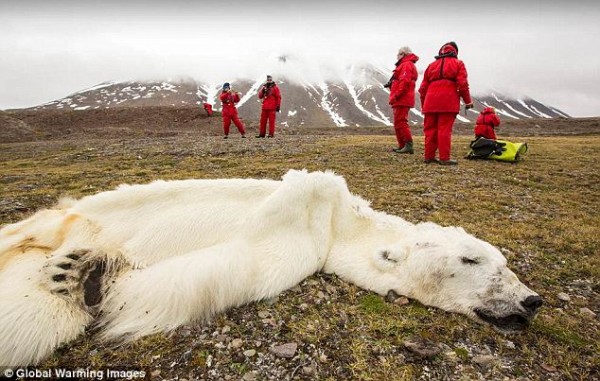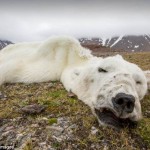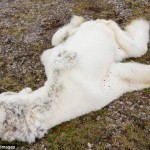- Experts found the carcass of a polar bear in Svalbard in the Arctic Ocean
- Lack of sea ice and seals forced the bear to search further afield for food
- Scientists claim climate change has reduced sea ice to record lows and is to blame for the death of this animal
- But some experts add that commercial trade in Canada is also to blame for falling polar bear numbers
The skin and bones of a male polar bear, that is believed to have starved to death, has been discovered washed up in Svalbard, in the Arctic Ocean.
Experts claim low sea ice levels caused by climate change meant the bear couldn’t hunt seals and this caused the bear to unsuccessfully search more than 150 miles for food.
Climate change is said to have reduced sea ice in the Arctic region to record lows and is ‘absolutely, categorically and without question’ the reason why polar bears are dying out, according to one wildlife expert.
Dr Ian Stirling from Polar Bears International has studied polar bears in the region for the past 40 years.
He told The Guardian that the way the bear was found, lying on its stomach, suggests that it starved to death and just dropped to the ground when it died.
There was no remaining fat on the bear either, and it had been reduced to little more than ‘skin and bone’.
Stirling claims that the lack of sea ice, which bears use to hunt seals, would have forced the bear to search further afield for food.
The bear’s search was unsuccessful and he starved to death while searching.
In April, researchers from the Norwegian Polar Institute were said to have captured and examined the bear in the south of Svalbard, an archipelago in the Arctic Ocean north of Norway.
At the time, the bear ‘appeared healthy’.
In July scientists discovered the bear’s carcass in the northern part of the archipelago, around 150 miles from where it has been spotted and captured in previous years.
This means the bear had travelled a significant distance from its home in search of food.
Research published in May found that the size and breeding success of polar bears was being directly affected by the fact the sea was taking longer to freeze and the animals had to spend more time on land.
This increase in temperature was attributed to climate change.
Only 20,000 to 25,000 bears are thought to remain and eight out of the known 19 species of the bear are said to be in decline.
Polar bears almost exclusively eat seals and they need sea ice to hunt and capture these seals.
In 2012 sea ice levels in the Arctic dropped to their lowest ever and the sea ice break around Svalbard earlier this year happened quicker and faster than in previous years.
Although climate change and its effect on sea ice levels is disputed, Douglas Richardson from theHighland Wildlife Park near Kingussie told The Guardian that: ‘This particular polar bear is the latest bit of evidence of the impact of climate change’ and ice loss due to climate change is ‘absolutely, categorically and without question’ the cause of falling polar bear populations.
Jeff Flocken from the International Fund for Animal Welfare is reluctant to attribute it completely to climate change, though, and also blames the commercial trade of polar bear parts in Canada as being a factor, too.
COULD CLIMATE CHANGE KILL ANIMALS ON THE SEA BED TOO?
Australian scientists have warned that seaweed could smother small creatures living on the sea floor on the coast of the Arctic and Antarctic if melting ice exposes their environment.
Animals including sponges that live in near perpetual darkness, protected by sea ice that blocks the sun’s powerful rays in spring and summer but if the sea ice melts as the Earth’s temperature warms up, they could be smothered by seaweed.
Biologists are worried that if the sea ice melts earlier on in the year, shallow-water ecosystems will soak up more sunlight and algae will spread across the sea floor, changing the habitat of sponges, tunicates and worms that anchor to rocks dramatically





Leave a reply